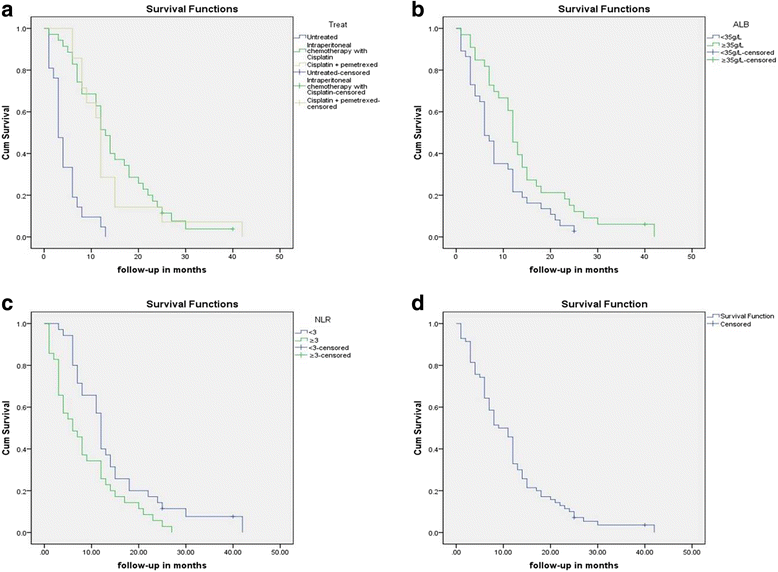Analysis of prognostic factors of patients with malignant peritoneal mesothelioma
- PMID: 29506546
- PMCID: PMC5836427
- DOI: 10.1186/s12957-018-1350-5
Analysis of prognostic factors of patients with malignant peritoneal mesothelioma
Abstract
Background: The study aims to find out independent prognostic factors for patients with malignant peritoneal mesothelioma (MPeM).
Methods: Patients with pathologically proven MPeM were retrospectively reviewed. Potential prognostic factors were analyzed, including age, gender, asbestos exposure, body mass index (BMI), treatment, and laboratory results, such as blood routine examination and liver functions. The influences of various risk factors on the prognoses were analyzed by univariate analysis. A Cox regression model analysis established independent factors for the survival prognosis of the patients.
Results: Seventy MPeM patients, including 33 patients who received intraperitoneal chemotherapy with cisplatin, 14 patients who received systemic chemotherapy with cisplatin + pemetrexed, and 21 untreated patients were included in this study. The 1-year survival was 32.9%, the 2-year survival was 10%, and the 3-year survival was 2.9%. The median age of MPeM was 62 years, and the female-to-male ratio was 1:0.56. The univariate and multivariate analyses showed that treatment, albumin (ALB), and blood neutrophil-to-lymphocyte ratio (NLR) were independent factors that affected the overall survival (OS) of MPeM patients.
Conclusion: High blood NLR and hypoalbuminemia are adverse prognostic factors for MPeM patients. Systemic chemotherapy and intraperitoneal chemotherapy can prolong the survival period.
Keywords: Albumin; Malignant peritoneal mesothelioma; NLR; Prognostic factors; Treatment.
Conflict of interest statement
Ethics approval and consent to participate
All procedures performed in studies involving human participants were in accordance with the ethical standards of the institutional and national research committee and with the 1964 Helsinki declaration and its later amendments.
Consent for publication
Informed consent was obtained from all included individual participants or their authorized families.
Competing interests
The authors declare that they have no competing interests.
Publisher’s Note
Springer Nature remains neutral with regard to jurisdictional claims in published maps and institutional affiliations.
Figures

Similar articles
-
First-line chemotherapy with pemetrexed plus cisplatin for malignant peritoneal mesothelioma.Expert Rev Anticancer Ther. 2017 Sep;17(9):865-872. doi: 10.1080/14737140.2017.1340157. Epub 2017 Jun 15. Expert Rev Anticancer Ther. 2017. PMID: 28594258
-
The Value of COX-2, NF-κB, and Blood Routine Indexes in the Prognosis of Malignant Peritoneal Mesothelioma.Oncol Res Treat. 2019;42(6):334-341. doi: 10.1159/000499677. Epub 2019 May 7. Oncol Res Treat. 2019. PMID: 31063993
-
Relationship between prognosis and neutrophil: lymphocyte and platelet:lymphocyte ratios in patients with malignant pleural mesotheliomas.Asian Pac J Cancer Prev. 2014;15(5):2061-7. doi: 10.7314/apjcp.2014.15.5.2061. Asian Pac J Cancer Prev. 2014. PMID: 24716935
-
Long-term regional chemotherapy for patients with epithelial malignant peritoneal mesothelioma results in improved survival.Eur J Surg Oncol. 2017 Jul;43(7):1228-1235. doi: 10.1016/j.ejso.2017.01.009. Epub 2017 Jan 29. Eur J Surg Oncol. 2017. PMID: 28189456 Review.
-
Peritoneal mesothelioma: the site of origin matters.Am Soc Clin Oncol Educ Book. 2013:182-8. doi: 10.14694/EdBook_AM.2013.33.182. Am Soc Clin Oncol Educ Book. 2013. PMID: 23714495 Review.
Cited by
-
Survival prediction in peritoneal mesothelioma: a nomogram based on SEER data and a Chinese cohort.Front Endocrinol (Lausanne). 2024 Sep 6;15:1432787. doi: 10.3389/fendo.2024.1432787. eCollection 2024. Front Endocrinol (Lausanne). 2024. PMID: 39309108 Free PMC article.
-
Overexpression of fibulin-3 in tumor tissue predicts poor survival of malignant mesothelioma patients from hand-spinning asbestos exposed area in eastern China.Sci Rep. 2020 Nov 23;10(1):20373. doi: 10.1038/s41598-020-77412-4. Sci Rep. 2020. PMID: 33230247 Free PMC article.
-
A single-center retrospective cohort study of perioperative systemic chemotherapy in diffuse malignant peritoneal mesothelioma.PLoS One. 2022 Sep 29;17(9):e0275187. doi: 10.1371/journal.pone.0275187. eCollection 2022. PLoS One. 2022. PMID: 36174024 Free PMC article.
-
Survivin expression as an independent predictor of overall survival in malignant peritoneal mesothelioma.Oncol Lett. 2020 Jun;19(6):3871-3880. doi: 10.3892/ol.2020.11505. Epub 2020 Apr 2. Oncol Lett. 2020. PMID: 32382335 Free PMC article.
-
Serum protein and electrolyte imbalances are associated with chemotherapy induced neutropenia.Heliyon. 2022 Jul 12;8(7):e09949. doi: 10.1016/j.heliyon.2022.e09949. eCollection 2022 Jul. Heliyon. 2022. PMID: 35865973 Free PMC article.
References
-
- Wei SC, Zheng GQ. Retrospective analysis of 162 patients with malignant peritoneal mesothelioma in Cangzhou residents. Chin J Intern Med. 2013;52:599–601.
MeSH terms
Substances
Grants and funding
LinkOut - more resources
Full Text Sources
Other Literature Sources
Medical
Miscellaneous

